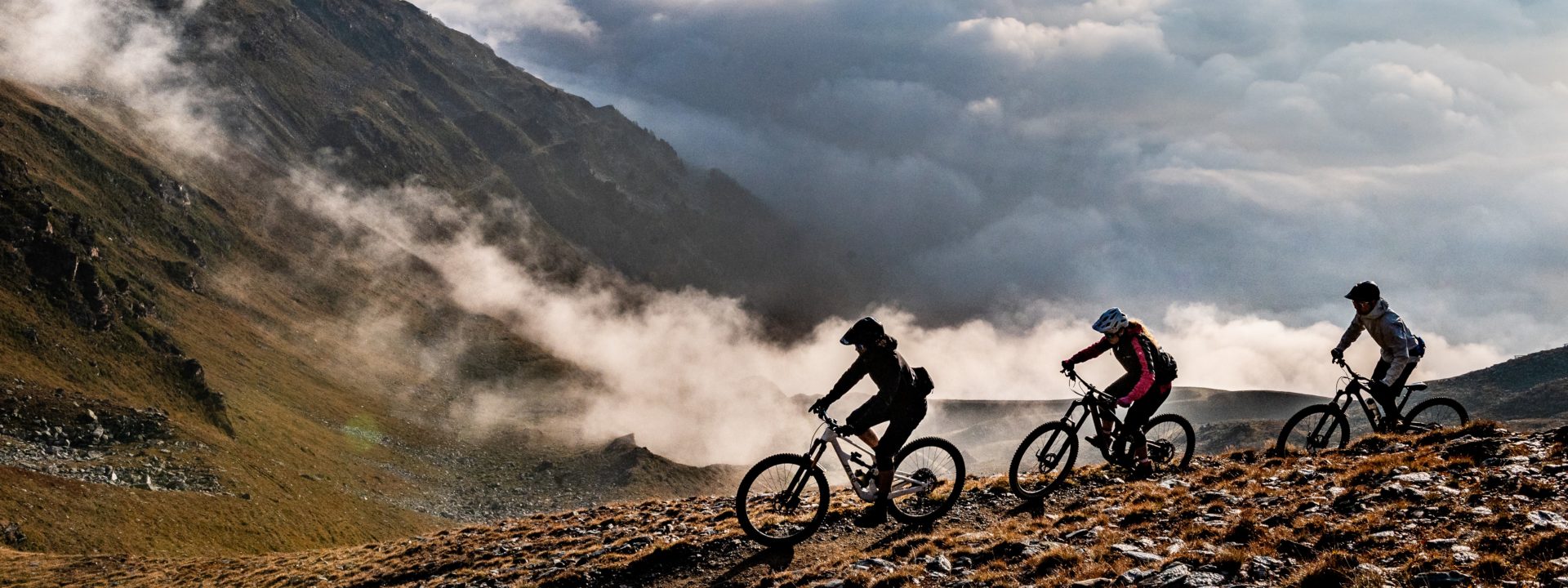
I stopped short on my bike, watching as the sun climbed over the Ortler in South Tyrol, Italy. Its warm rays pierced the autumn air draped around my friends, who stood in awe of the sunrise. Finally, pushed on by hunger, the four of us turned our backs on the jumbled glaciers, zipped up our jackets, and peddled off for a technical alpine descent. After warming up in a small hütte with coffee and cakes, we traded the morning´s technical trail for fast lines through farmland and forests before popping out on the valley floor of the Vinschgau. From here, it was a casual peddle back to our pension amidst apple orchards and the familiar bustle of holidayers.

While the Vinschgau is no secret in the mountain bike community, myself and three friends– Paula, Marco, and Francesco – had arrived in early September 2021 on a two- wheeled mission to understand what allowed mountain bike trails to flourish in this Italian border region.
The curiosity for this trip was sparked in the spring after riding in Innsbruck with Francesco Drago, an all-things endurance powerhouse, and Marco Siedl, a lover of the descent. Throughout the day, we discussed the challenges mountain biking faces across various Alp regions and how the growing sport often faces off with landowners, farmers, and tourism industries who are seemingly more interested in supporting traditional hiking and leisure tourism. The conversation left us wondering how mountain biking was booming in the Vinschgau? A place where trails wander through private land and share dirt with popular hiking routes, all without seeming to throw red flags from the forest service, landowners, or tourism industry.
Over the coming weeks, I made phone calls and searched for answers until finally, I met Matze Grubby – born and raised in the Vinschgau, the long-time trail developer, owner of Vinschgau Bike, and founder of www.mountainbiker.it suggested the best way to answer my questions was to come and experience them with his insights. Fueled by this offer, Marco, Francesco, and our friend Paula Islinger – a passionate enduro rider – agreed that a week of Italian research was perfect for the complicated year of travel.
Surfing trails in Latsch
Our first ride of the week took us to Berbahnen-Latsch. Atop the sleepy two-seater chairlift, we found a modern network of flowing lines weaving down the mountain past old shepherd´s huts via bermed-corners, fast straights, and extracurricular drops. All of this, we would learn, helps keep you flowing to reduce heavy braking, which scars the trail and requires extensive erosion maintenance.
In Latsch, we were also introduced to the concept of a locally engaged trail community. One such member is the Trail Doctor Gabriel Tappeiner. The organic apple farmer and trail builder acquired this nickname after his passion for riding led to an invitation to work on the surrounding trails. Like his apple farming, he approached trail building with the ethos of being in harmony with nature. The result, designing and maintaining trails to use the flow of the landscape and natural materials for building, leaving little more impact on the environment than a strip of singletrack.
Like his organic apple farming, he approached trail building with the ethos of being in harmony with nature.
Having warmed up our suspension and knowledge, we zipped over to the Vis-ã-vis café in Coldrano, a biker hot spot with a laid-back vibe set amidst palm trees. The plan, an evening meet-up with Matze. First though, with the encouragement of Francesco, we had our inaugural apple strudel.
There is always time for a cake and coffee stop in the Vinschgau, because as Francesco always says, “strudel just tastes better here, with the apples fresh off the trees.”
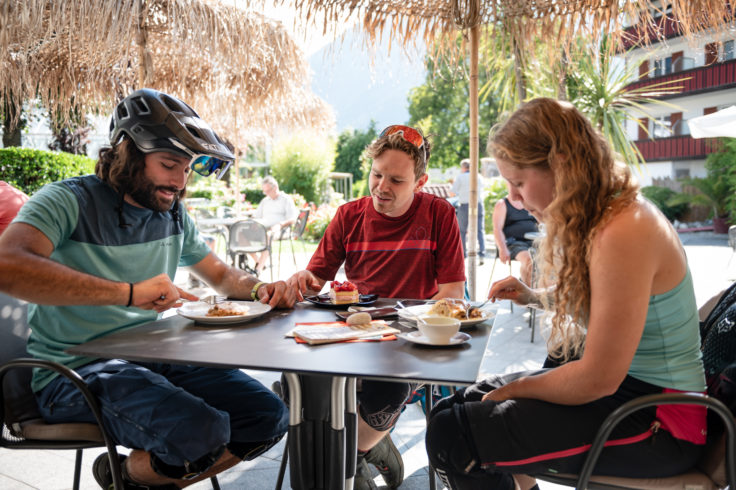
Back astride our bikes, to the backdrop of farmers haying a field, Matze gave us a lay of the land for mountain biking. In the Vinschgau, the towering peaks of the Alps follow old military tracks for lung-busting climbs followed by steep, technical descents that have become a dream of switchback turn enthusiasts. This singletrack rolls down into the more forgiving sub-alpine farmland that transitions into terraced vineyards before joining apple orchards on the valley floor. This sub-alpine is home to the modern flow trails and the first bike-specific routes.
The famous Holly Hanson trail
The most famed of these sub-alpine trails might be the Holly Hansen. In 2011, this was Matze´s first build. It was also the first bike-specific trail developed outside of a ski resort in South Tyrol and the first time the Alpine Club and Forest and National Park administration authorized outside trail work. Which, as we learned, required an approach coined as the Italian Way Matze´s principle of slowing down, talking over coffee, and getting a community to understand and connect around mountain biking.
We not only got a lay of the land and an insight into the history of the famed Holly Hansen trail, but we also began to see the importance the community plays here in coming together to support biking.
Matze explained the Holly Hansen not only required stretching a hairline budget through volunteer work, but it also took patience. And above all, a willingness for countless hours spent talking with farmers, hotels, tourist organizations, the forest service, and permit committees. Through this experience, he shared his view that getting permission and developing a trail is an effort the local riders should lead. The result creates something that the locals are motivated to ride, respect, and maintain. As opposed to what a planning or tourism board thinks will thrive. But as he explained, “this process can´t proceed without a respect for others´ opinions or concerns, and investing time to sit down, listen, and problem solve; not just make demands or cut trails illegally.”
Riding perfect rollers on the Propain trail
As we wrapped up the conversation, we clicked into high gear and peddled to the Propain trail, another of Matze´s creations. With the evening sun warming our descent, the route unfolded in front of us, and we dropped in for a demonstration of a trail built to suit the local rider´s interest, which in turn, they still maintain. I watched as Paula, Marco, and Francesco rolled into a steep gully that incorporated jumps and perfect rollers for tail whips. As I chased the trio around the corner, they carved dusty chicanes down the hillside before entering a fast traverse into a rock garden that led back to the valley. If it weren´t for the call of dinner and early bedtime, peddling up for a second lap would have been mandatory.
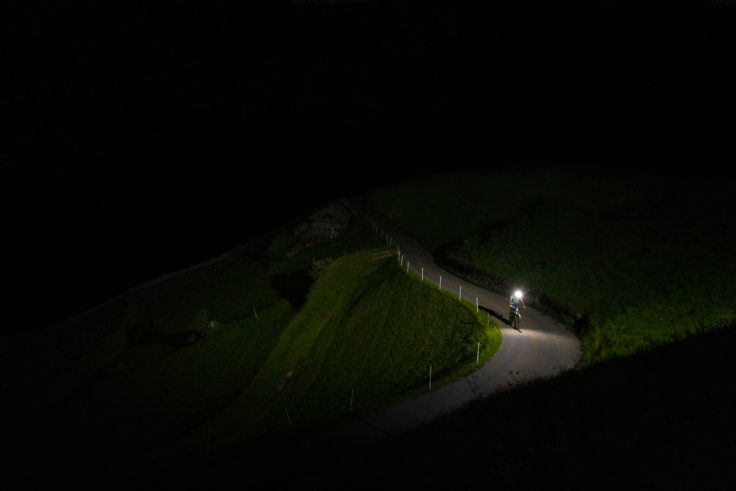
The Schartlkamm trail – the best alpine ride in South Tyrol?
The following day, standing in the dark at the shuttle drop somewhere around 1.300 meters, Marco clicked on a daylight-worthy headlamp illuminating Paula, who was layering up to fend off the bite of 4 am air. After the quick exchange of fist bumps with Matze, the three of us peddled off to catch Francesco´s alpine-start agenda of minimal standing. Our unconventional start for the Schartlkamm trail arose through the necessity of dodging a rainy forecast in exchange for a sunrise ride. Marco, the notoriously late riser, had us convinced when he encouraged it, clamming this to be “the best alpine ride in South Tyrol. That even without views of the Ortler or glaciers, the landscape and trail variety make it a must-do.”
Finally, catching Francesco at a complete stop, we set our bikes off our shoulders at 2.447 meters and joined in appreciating the sunrise. Although it was not a technically demanding climb, the last few hours had been a mental game as we peddled up a steep farm road before reaching singletrack. Here the predawn glow broke darkness for a short section before we shouldered our bikes for the last 300 meters. Our efforts were paid in full, though, as we watched the sunrise over the Ötztal Alps.
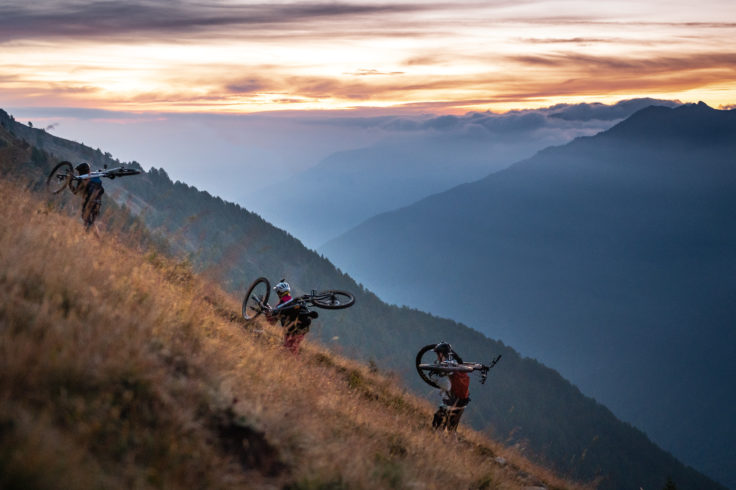
The trail lived up to Marco´s recommendation. Dropping in, we surfed a ridgeline that split alpine meadows and rock outcrops before plunging into the woods for dry, dusty maneuvering. All of it technical and fast enough to pique your adrenaline and concentration before finally dropping you out on a forest road.
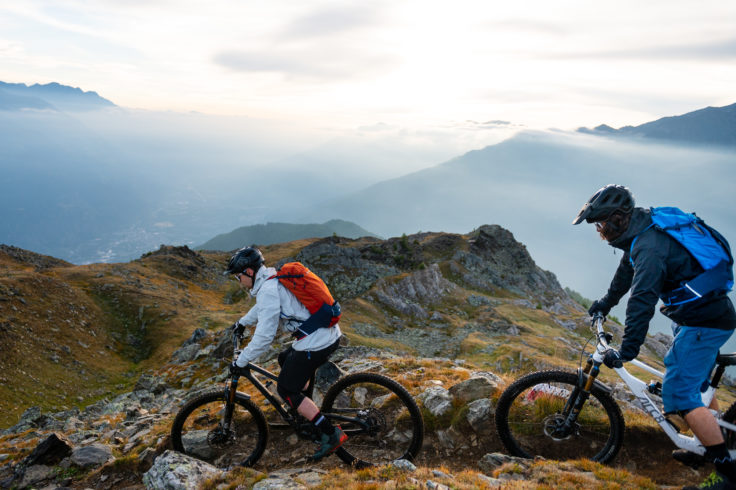
Up to this point, following the trail had not been a problem, and although we later found well-marked trail signs, we were glad to have the GPS as we crisscrossed dirt roads. For this, the week´s suggestion of using GPS maps supported by the local guides or even mountainbiker.it to help ensure you are not following unneeded shortcuts or crossing private lands reduced our wandering en route to the Haslhof. After a round of cakes, coffee, and relaxing, we celebrated our luck of good weather with a descent of the Holly Hansen trail. It was fast and thoroughly engaging – living up to its reputation.
We filled the next few days dodging bad weather on sub-alpine rides, some mandatory bike maintenance, and plenty of traditional food. Our gluttony ranged from cheese boards and speck to Knödel and fresh pasta. But our lessons weren´t over.
Over time we were learning the Italian Way, and how the Vinschgau community bands together to first increase biker awareness locally while slowing down to listen to the community concerns and environmental issues.
Trail building at the Aigen trail
On one of our last evenings, we wandered down the Aigen trail following Matze with rakes and shovels in hand. Initially, our conversation focussed on trail maintenance and rebuilding lines, which brought up his condemnation of shortcutting at all costs in favor of riding, protecting, and maintaining the existing trails. But he suggested, “for trail builders, it is important to consider where and why bikers are shortcutting early on. Then, if these new lines make better sense for the natural flow of the trail, they should be built out while closing off the original section to support regrowth.” A matter he suggests is managed through coordinated trail maintenance; not every rider´s opinion in a free-for-all.
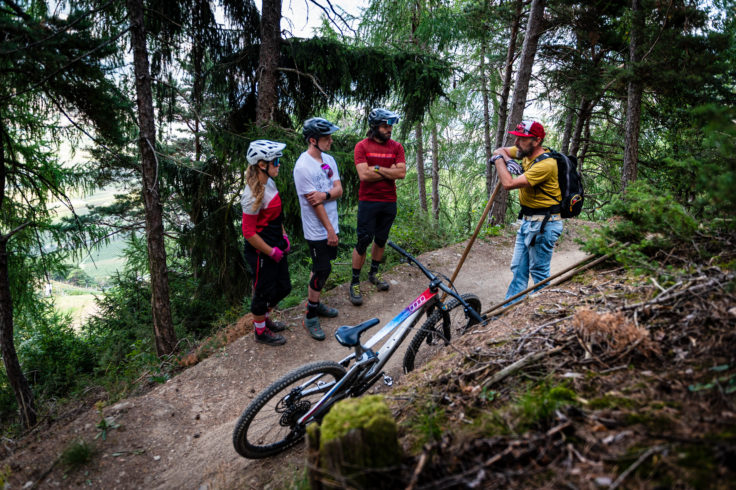
Sitting trailside, the conversation shifted back to the community and the role everyone plays in keeping trails open. For instance, yielding to hikers and being friendly to other trail users helps break down the stigma around biking, which leads to pushback from hotels and tourism organizations for future development and funding.
As he put it, show hikers that just because they once met an unfriendly or rude biker, this isn´t every biker.
Through his interaction with the International Mountain Bike Association in the United States, Matze has adopted many principles that help mountain biking flourish locally. For example, with IMBA, he observed well-organized trail-building days supported by volunteer riders and an organization that helps promote sustainable mountain biking in terms of development, the landscape, and shared trail use. In the Vinschgau, these principles have brought riders together, ranging from athletes and guides to farmers, business owners, and mayors, all interested in sustaining biking in a mixed-use region. Some results from this include better trail markers, right-of-way signs, and agreements to designate specific shuttling and peddling times on mixed-use trails.
The endless Goldsee trail
The following morning, we peddled to our customary pick-up in Schlanders to meet another local who was excited to share a different sort of bike experience, a predawn shuttle up Passo Stelvio. Although starting the Goldsee trail by 9:00 am is mandatory to accommodate the biker hiker agreement, our unusual start came from the encouragement of not missing sunrise over the Ortler. Thus, after a short hike-a-bike and a crisp peddle, the four of us stood watching the show of reds, pinks, and purples blanketing the Ortler. This brings us back to where the story began and a 3.000-meter descent through the clouds back to the
valley floor.
Peddling home along the apple-lined bike path, we discussed plans for our last day. We were headed to the Reschensee to ride the Schönebenbahn Enduro trails. But hard-hitting resort laps weren´t on my mind. Instead, I wondered aloud, “had we found any answers to our questions, or was this was just simply an excuse to ride with friends?”
Our conclusion on trail building, community engagement, sustainability and communication
As we discussed the past week, Paula helped ease my question. “It is interesting to see how much discussion and communication it has taken here between the farmers, bikers, tourist boards, and foresters to create acceptance for mountain biking. It´s a whole other aspect to the bike community which we rarely even talk about or pay attention to.”
“For me, this week has further supported my vision in creating a shop as a hub for riders to gather and a place to develop forward-thinking around biking” Marco added. Referring to the shop, Dust Bikes in Innsbruck, he was finalizing the concept of. Francesco, a POW Community Organizer, interjected; the week´s conversations bolstered his view of “not shortcutting lines or supporting illegal trail building. Not only is it damaging the environment, but as we have discussed, we need to organize ourselves if we aren´t happy with our local trails.”
I think then; I finally grasped what we had collected. It wasn´t the golden answer for every region to replicate. Instead, it was an understanding that sustainable growth in riding is in the hands of the community, all of us. This is not only a community for getting out and riding but for coming together to work on and develop what we already have, or our future wants, and community workdays.
And if local land managers or municipalities are against biking, consider the Italian Way; Then, slow down, have a coffee, and take time to listen and discuss sustainable solutions.

Text & images by Tristan Hobson
- Richie Schley & Mo Jungaberle – Generations apart
- Mountainbiking in the Basque Country
- Hinterlasse keine Spuren! – Mountainbiken
- Sustainable Mountainbike clothes, shoes and backpacks
- VAUDE Mountainbike videos on Youtube














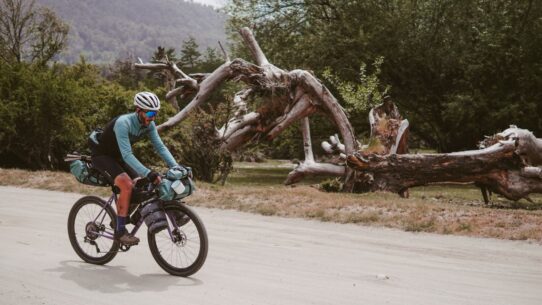
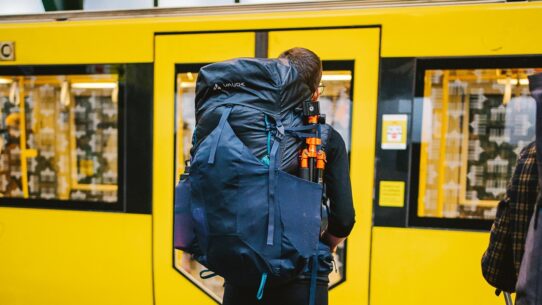
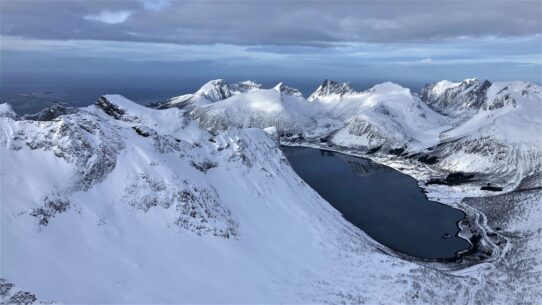

Comments